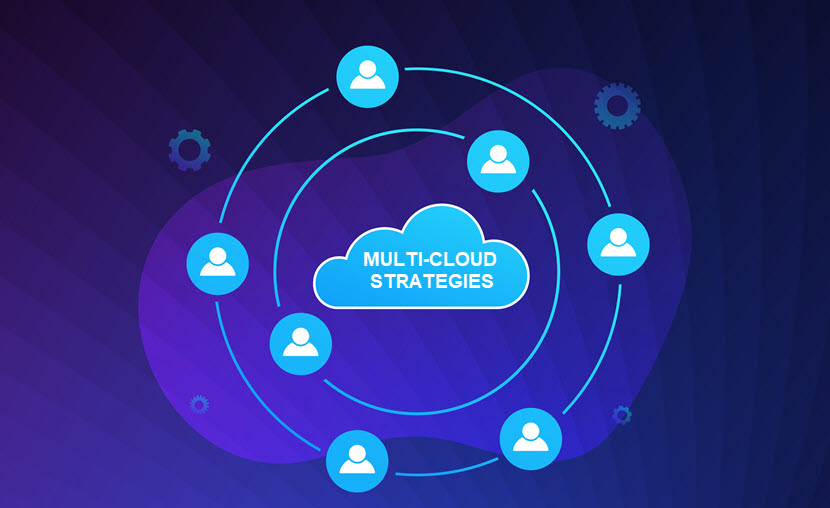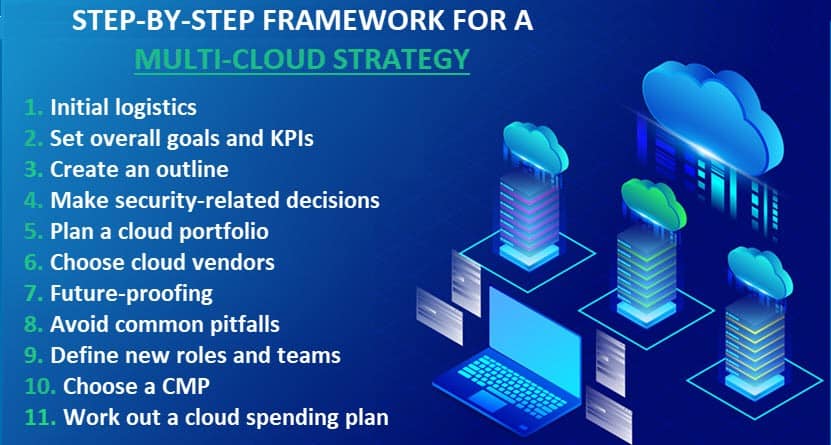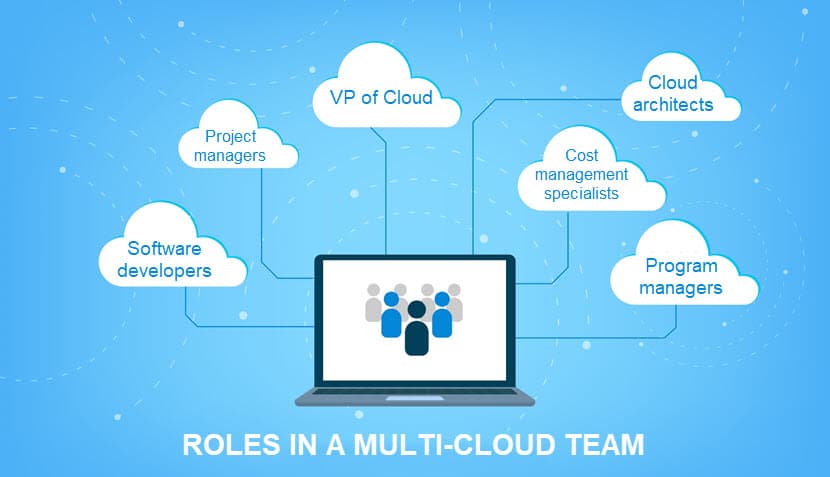While multi-cloud can improve availability and eliminate vendor lock-in, the success of using multiple clouds is not a guarantee. Companies require a sound multi-cloud strategy to ensure they do not run into operational or financial issues.
This article helps business owners and decision-makers create an effective multi-cloud strategy. Read on to learn how to plan a move to multi-cloud and prepare your company for the impending cultural shift.

Why Should You Adopt a Multi-Cloud Strategy?
A multi-cloud is a challenging environment to set up and run, and an overarching strategy ensures a company is ready to take on the challenge. A well-thought-out plan helps:
- Set up an efficient multi-cloud environment.
- Ensure a high ROI.
- Stop cloud security threats and risks.
- Ensure smooth expansions in the future.
A multi-cloud strategy helps maximize the effects of using multiple clouds, including:
- Deploying the best market solution for each task and workload.
- Better cloud disaster recovery.
- High availability.
- Easier and faster cloud migration.
Many companies move into multiple clouds gradually and without a plan, typically one service or application at a time. This approach quickly becomes unwieldy and leads to cloud sprawl, uncontrolled management of cloud instances, services, or providers. A sound multi-cloud strategy prevents sprawl from hurting your efficiency and budget.
A multi-cloud strategy also ensures you are ready for what the new setup requires from your organization. The shift to multi-cloud demands:
- Managing two (or more) different vendors.
- Understanding the financial models of all services.
- Efficient integration across all setups.
- Security operations that protect all environments.
Not ready for multi-cloud? Consider setting up a hybrid cloud, a model that also combines multiple IT environments but offers more direct control.
Multi-Cloud Strategy Implementation
Ideally, a company should create a multi-cloud strategy before deploying to different clouds. A timely plan ensures each decision fits into the broader picture.
Below is an 11-step framework for creating a multi-cloud strategy. This executive-level plan helps understand the objective behind multi-cloud and the requirements for the new environment.

Initial Logistics
Creating a multi-cloud strategy starts by reflecting on your requirements. At this initial point, you need to:
- Determine the reason why you want to deploy to multiple clouds.
- Make a list of your technical requirements.
- Decide whether you will create the new environment in-house or via outsourcing.
- Set rough project deadlines.
- Allocate the project budget.
This high-level guideline helps with decision-making in all subsequent steps. The early appraisal is also an opportunity to assess if a simpler deployment model is a better fit for your use case.
Learn about the most common cloud deployment models and see the different options available to your business.
Set Overall Goals and KPIs
You need to establish the areas in which you expect multi-cloud to deliver business value. Typically, companies focus on one or two domains and turn them into deployment goals. Common objectives include:
- Eliminating vendor lock-in: Without the ability to switch to new clouds and vendors, you have limited options for pricing, discounting, and features. A goal of multi-cloud can be achieving the flexibility to move between vendors without restrictions.
- Reaching new markets: Companies often decide to deploy a multi-cloud to ensure optimal performance without latency across different geographic locations.
- Faster application delivery: Multi-cloud provides nearly instant access to compute resources. The lack of delay accelerates the delivery of new code, so the deployment goal can be to speed up the rate at which developers ship applications.
- Enhancing automation: Automation and self-service models make IT teams more efficient. Companies often decide to deploy a multi-cloud to allow the staff to focus on business-critical assignments instead of low-value, repetitive tasks.
- Reduce overall costs: Multi-cloud reduces costs due to cheaper compute resources, less excess capacity, and no hardware expenses. A common goal behind a multi-cloud is to bring the overall IT price under a specific financial threshold.
Once you set the overall goal of multi-cloud deployment, you have your KPIs and are ready to continue working on the overall strategy.
Make the Strategy Outline
Consider the following areas to determine the direction of your multi-cloud strategy:
- Applications you have and the clouds they require.
- Features, capabilities, and services you need for efficient performance.
- Suitability of cloud for different apps and workloads.
Understanding your applications and their requirements is vital for a good outline. Answer the following questions:
- What apps require high availability?
- What data and processes need the most protection?
- Which apps and areas require significant scaling (up or down)?
- What workload belongs in what type of cloud?
Be cost-aware at this point to avoid needless spending in the future. For example, an app that runs a few hours per day is not a good fit for a 24/7 cloud. You can cut costs by using a vendor that provides the correct service for each app.
Be aware that switching to a multi-cloud will impact all core IT teams (operations, security, networking, and development). Open a line of dialog with each department to:
- Get their input into applications, processes, and everyday workflows.
- Ensure everyone buys into the multi-cloud deployment and prepares for the cultural shift.
Your outline needs to include a plan for migrating on-prem services to the cloud and any modifications to the apps to make them cloud-friendly. Also, you and your team should specify rules for building, testing, and running apps that will interact with cloud services.
Unlike in hybrid architecture, multi-cloud demands tight integration between clouds and data migration between environments. Know that your portfolio requires high levels of interoperability to function smoothly. However, remember that not all processes require this portability, which is another cost-saving opportunity.
Our comparison between multi and hybrid cloud helps you understand the differences between the two similar deployment types.
Make Security-Related Decisions
Cybersecurity should never be an afterthought, so ensure your multi-cloud strategy accounts for security measures from the start. Your plan should include:
- Security controls for each environment and the entire setup.
- Cybersecurity best practices the team needs to follow.
- Tools that ensure a safe multi-cloud environment.
Decide if your future cloud provider will be responsible for securing some tasks and processes or whether you want all security to run in-house. Also, make sure your strategy accounts for any compliance or government regulation in your industry.
This step is the perfect time to start working on your cloud security policy, a formal guideline that defines how your company operates in the cloud.
If possible, consider assembling a DevSecOps team to add a security-first mindset to your new setup. DevSecOps is a dynamic department that integrates security into your CI/CD process and ensures optimal protection at all stages of the software development life cycle (SDLC).
Learn more about phoenixNAP Confidential Computing Solutions to rise to the growing challenge in cloud security.

Plan a Cloud Portfolio
Now that you understand the requirements of your apps, you need to design a cloud portfolio. When assembling a portfolio, the first important decision is to determine how many clouds you need. A multi-cloud environment requires at least two public clouds but consider if an additional private cloud can benefit the environment.
You should also decide whether you want a homogenous or heterogenous setup:
- A homogenous cloud includes several clouds from the same vendor.
- A heterogeneous cloud integrates public and private components from different vendors.
Based on your outline, consider if you require IaaS, PaaS, or SaaS for your portfolio. Also, make sure to consider your team’s skillset. For example, if the team only has engineers experienced with Azure, it does not make sense to adopt AWS without bringing in more talent.
Choosing Cloud Vendors
Now that you know your goals and requirements, it is time to choose a cloud provider. Performance levels and cost savings depend on this decision, so conduct a comprehensive assessment before siding with anyone.
The first step is to find providers that fit your budget. Then, filter your options by matching each app’s requirements to what the vendor offers in terms of:
- Features.
- Unique and extra services.
- Technical characteristics.
Most cloud vendors offer free trial services. A test period allows you to check if a particular vendor fits your needs and expectations. Set up environments with two or more providers and conduct proofs-of-concept with free trials to see how the operations run before committing to anyone long-term.
For optimal performance, your provider should have direct connectivity with the largest cloud infrastructures. This capability ensures multi-cloud operates at a high level, even as a heterogeneous system.
Our data center in Phoenix has an AWS direct connect point and a streamlined connection with Google Cloud, making pNAP an ideal option for multi-cloud setups.
Future-Proof Your Multi-Cloud Strategy
Multi-cloud setups need regular upgrades to remain efficient. Planning ahead is a must if you wish to be ready for market changes and keep your systems healthy. Ensure your multi-cloud strategy accounts for:
- Deployment of new services and applications.
- Expansions of your workforce.
- Upcoming adoption of new solutions or technologies.
Future-proofing your strategy also extends to your vendors. Besides ensuring providers match your current requirements, know that each third-party vendor must fit into your foreseeable plans. While a multi-cloud prevents vendor lock-in, you still do not want to switch hosting partners regularly.
Overcome Multi-Cloud Strategy Challenges
The two most common pitfalls of any multi-cloud strategy are governance issues and excess costs.
A public cloud allows teams to provision resources within minutes, so companies need visibility over resource usage. Consider implementing frictionless governance that embeds and automates necessary controls while allowing teams to deploy cloud resources quickly and easily.
Keeping cloud bills in check is another common issue due to the on-demand pricing model of cloud computing. You need a fundamentally new way of thinking about infrastructure spend, so your strategy must account for cloud sprawl and resource waste. Also, ensure your team:
- Understands different cloud pricing models with different SKUs.
- Knows how to allocate cloud budget.
- Can forecast cloud usage and costs.
- Knows to track spending and identify waste.
- Is familiar with optimization techniques and automation policies.
- Can analyze complex cloud discount options.
- Knows how to define resources with different tagging strategies.
Multi-cloud can save you money, but it can also pick your pockets if you don’t track expenses.
Lower your cloud bill with a cloud cost optimization solution.
Start your FREE trial today!
Define New Roles and Responsibilities
Hybrid and multi-clouds require more expertise than any other cloud deployment type. Your team’s skill set is crucial both for short and long-term strategizing.
The staff behind a multi-cloud must know how to manage the system to ensure reliable and scalable performance. Ensure the team is proficient at:
- Multi-cloud operations and orchestration.
- Cloud monitoring.
- Automated provisioning.
- Infrastructure as code (IaC).
- Horizontal scaling.
- Native cloud services.
- Cloud computing security.
- Disaster recovery.
Companies typically create a dedicated team when deploying a multi-cloud. Primary roles of a cloud team include:
- A VP of Cloud that drives cloud initiatives.
- Cloud architects.
- Software developers.
- Cost management specialists.
- Project and program managers.
Ideally, your cloud team should also include part-time or full-time representatives from other departments, namely:
- Operations.
- Application development.
- Integration and networking.
- Security.
- Finance.
Some enterprises go one step further from cloud teams and form Cloud Centers of Excellence (CCoE). While expensive, these departments have fully staffed teams of experts who drive cloud-based transformation across an organization.

Choose the Right CMP
Choose a cloud management platform (CMP) that allows the team to handle different environments from a single pane of glass. This central tool should provide:
- Overviews of cloud billing and provisioning services.
- Simple inventory and cloud resource management.
- Third-party integration and tools management.
- Business intelligence.
- Governance and access controls.
- Administration of automated policies.
- Multi-cloud brokering and provisioning features.
- Monitoring and alerting systems.
The CMP should work with the tools your team is already using. As every multi-cloud strategy should include tools that the team knows how to use, ensure your new CMP integrates well with the current toolchain.
Also, ensure the tools and different clouds have integrated databases. Otherwise, you risk creating data silos and databases that do not communicate with each other.
Make a Cloud Spending Plan
The last step in creating a multi-cloud strategy is to define a spending budget and methods of staying within the allocated resources.
Unfortunately, keeping fluctuating cloud computing costs in check is challenging. Companies spend over $14 billion on unnecessary cloud infrastructure annually, so consult with an expert specializing in managing cloud costs. Alternatively, you can control expenses by deploying a cost optimization tool that will help:
- Structure cloud accounts and bills.
- Identify saving opportunities.
- Enforce governance rules.
- Automate provisioning.
- Provide accurate cost tracking and spend reporting.
- Alert you in case of unnecessary spending.
To help manage your expenses, use a cloud cost management tool.
Make a Timely Plan and Ensure a High ROI on Your Multi-Cloud Investment
Companies of all sizes are moving away from expensive data centers in favor of cloud-first solutions. If you decide to deploy a multi-cloud, a sound strategy can provide a framework for a smooth and cost-efficient adoption.
Next, learn about multi-cloud management tools that can help you monitor, manage, and secure cloud resources as well as optimize performance and spending.



